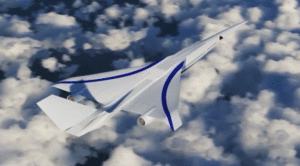TORRANCE/USA — In a stunning blow to the future of commercial aviation, Exosonic, the ambitious startup that aimed to revolutionize air travel with supersonic passenger flights, has filed for bankruptcy. Despite raising millions in funding and making significant strides in aircraft design, the company has been unable to secure the financial backing required to bring its vision to life.
Exosonic, founded to rekindle the era of supersonic flight in a more sustainable and economically viable form, had garnered widespread attention for its bold promise to bring back speeds above the speed of sound for commercial airliners. The company’s primary focus was on creating a next-generation supersonic jet capable of flying at speeds of up to Mach 1.8, or roughly 1,300 miles per hour (2,092.15 km/h), while also reducing the environmental impact typically associated with supersonic travel, such as the disruptive sonic boom.
A Bold Vision Meets Financial Reality
The company’s flagship project was the “Sonata” — a sleek, environmentally-conscious supersonic aircraft designed to carry passengers at speeds faster than current subsonic jets, cutting long-haul flight times significantly. Exosonic promised quieter operations and a potential reduction in carbon emissions compared to earlier supersonic models, such as the Concorde, through innovative technologies like noise-dampening designs and sustainable aviation fuel (SAF).
However, the company’s vision has now come to a premature end. Despite securing millions of dollars in investments from venture capital firms and partnerships with aerospace giants, Exosonic has been unable to bridge the significant funding gap required to develop its aircraft. Industry experts had long warned that the capital-intensive nature of supersonic aircraft development would demand billions in investment to overcome engineering hurdles, regulatory approval, and the complex task of certifying supersonic flight for commercial use.
“The dream of returning to supersonic travel is still alive, but Exosonic’s inability to raise the necessary funds highlights the severe financial challenges such ambitious projects face,” said aerospace analyst Thomas Hale. “The technology may be promising, but the economic realities have proven too great a hurdle.”
A Takeover Looms? Potential Buyers Eyeing Exosonic’s Patents and Tech
Exosonic’s intellectual property (IP) and technological advancements remain highly valuable despite the financial collapse. The company has made significant progress in the areas of aircraft design, aerodynamics, and noise reduction technology — all critical components for the future of supersonic travel.
Industry insiders believe that several major players in the aerospace and aviation sectors could be interested in acquiring Exosonic’s patents and technology, particularly as the market for supersonic air travel continues to grow. Companies such as *Boeing*, *Lockheed Martin*, and *Airbus*, who have shown interest in supersonic projects in the past, could be eyeing Exosonic’s innovations to bolster their own programs. Additionally, *Virgin Galactic* or *Boom Supersonic*, two other companies involved in supersonic jet development, could be potential buyers seeking to fast-track their projects or integrate Exosonic’s technology into their own designs.
“There’s a clear appetite in the industry for supersonic technology,” said aerospace consultant Jane Park. “While Exosonic may not have the financial backing to finish its journey, its patents and technology could be a valuable asset to larger, better-funded companies that are looking to bring supersonic flights to market in the coming decades.”
Exosonic’s failure to secure additional capital has also raised questions about the future of commercial supersonic aviation. While companies like *Boom Supersonic* have made strides in attracting investment and developing their own supersonic airliners, the market remains highly speculative, with many hurdles left to clear before such flights become a regular part of global travel.
Looking Forward: The Future of Supersonic Travel
As Exosonic’s bankruptcy proceedings unfold, attention will shift to whether any of the company’s assets are sold off or if a larger player will step in to salvage its promising technology. While the bankruptcy marks a significant setback for the broader goal of reintegrating supersonic flight into the commercial sector, the race to develop faster, more efficient aircraft is far from over. For now, the dream of supersonic travel remains on pause, but with companies like *Boom Supersonic* and others continuing to make progress, it may not be long before the skies experience another supersonic renaissance. (zai)

